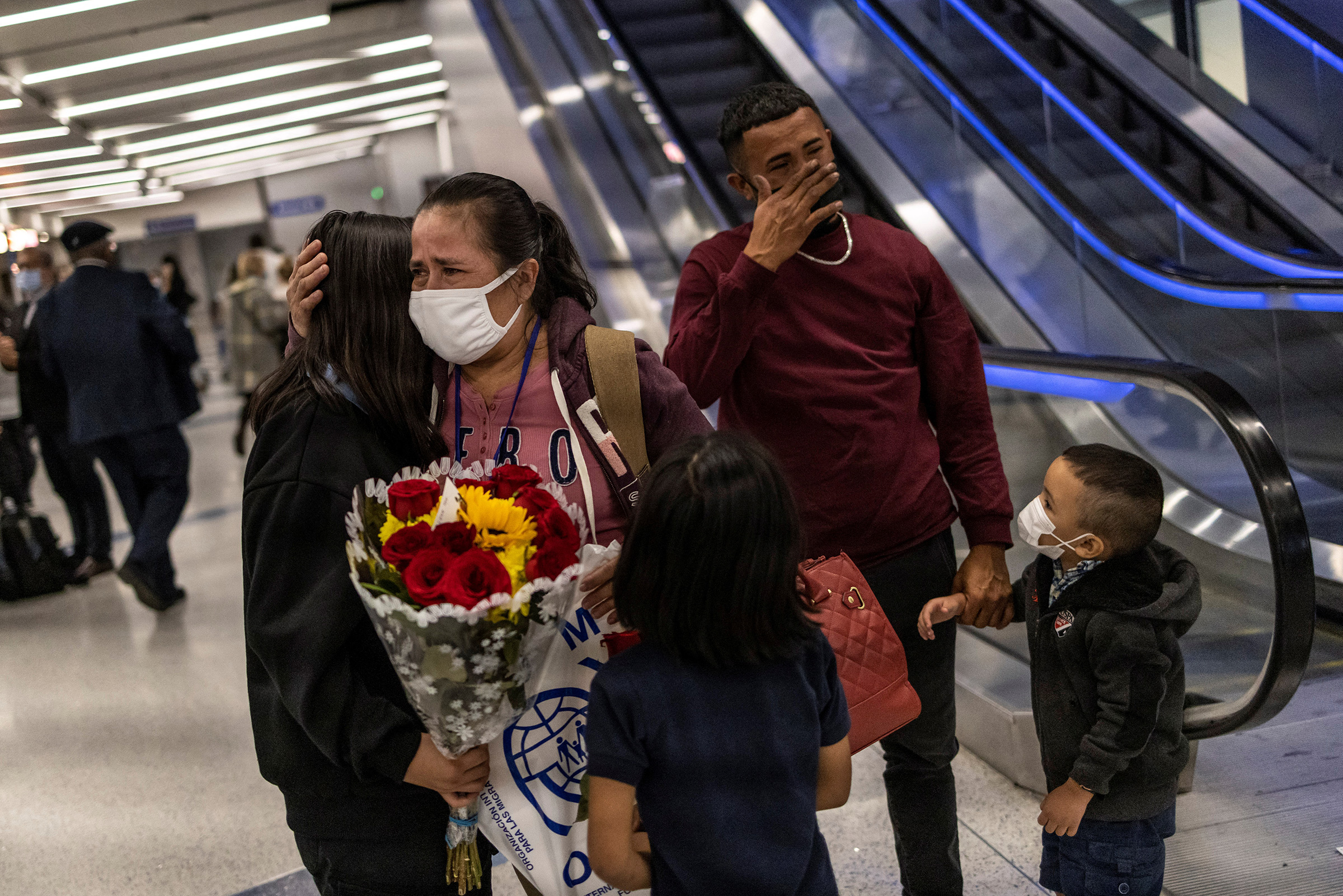
One year after President Biden issued an executive order forming the Family Reunification Task Force, roughly 130 children who were separated from their families at the United States-Mexico border under the Trump Administration have been reunited on U.S. soil, according to the Task Force. About 400 parents have also begun the reunification process, leveraging new pathways, including a website, that were built by the Task Force this past year.
In an interview with TIME this week, Department of Homeland Security Secretary Alejandro Mayorkas cheered the program’s progress, while also calling on Congress to fund the Task Force and create a pathway to citizenship for reunited families. “We are advocating for legislation that will provide the families with the stability that we think they deserve,” Mayorkas said.
Family reunifications have so far been conducted through an ad-hoc immigration channel, known as humanitarian parole, that must be renewed in three years and does not provide a path to permanent residency. The Task Force is finding that some families are “reluctant to come forward because humanitarian parole provides temporary relief,” Mayorkas said.
The effort to undo the damage of the Trump Administration’s Zero Tolerance policy is still in the early stages. Michelle Brané, the executive director of the Task Force told NBC News that as many as 1,200 families remain separated. The parents of 237 children have not yet been located or contacted, as of January 5, according to court records in an ACLU lawsuit against the government. According to a joint status report submitted by the ACLU, the organization believes these parents were deported without their children.
Read more: Parents Deported Under Trump Can See Their Kids Again. But a Long, Hard Journey Awaits Them
The reunification effort is also facing financial challenges. Because the Task Force didn’t exist before February 2021, it did not receive Congressional funding, according to a DHS spokesperson. The Task Force currently arranges work authorization for families after they’ve arrived in the U.S., and provides access to free mental health care, but it relies on NGOs—including Together and Free, Seneca Family of Agencies, and Al Otro Lado—as well as the United Nations High Commissioner for Refugees (UNHCR), and the International Organization for Migration (IOM) to also shoulder the considerable logistical and financial burden necessary to help separated parents return to the U.S. Without Congressional funding, the Task Force will be limited in the scope of what it can do going forward.
“It is our hope that we reunify all the families who were separated under the cruel policy of the past Administration” in the next year, Mayorkas said. “That is our goal and we’re working incredibly hard to achieve it.”
Humanitarian Parole
The Task Force has spent the past year building “the architecture” of reunification, Mayorkas says. That includes developing partnerships with international organizations; building a website families can use to come forward and begin the reunification process; and finding the legal mechanisms through which the government can return families who were separated to the U.S. The Task Force has also assembled a detailed database of the people separated under the Zero Tolerance policy. Improper record keeping during the Trump Administration is one reason family reunification is such a challenge, Mayorkas adds.

The challenges facing DHS remain acute. The Trump Administration spent years systemically dismantling the U.S. immigration system, which remains severely understaffed and underfunded. In 2017 and 2018, most of the staff in the Refugee Affairs Division of U.S. Citizenship and Immigration Services (USCIS) were temporarily reassigned to asylum processing, according to the Migration Policy Institute (MPI), a nonpartisan research institution. While most were later reassigned, attrition rates were high and the disruption reverberated across the agency.
“Let me be very clear. Our processing times are too long,” said USCIS Director Ur Jaddou in a Wednesday public briefing. “There are no ifs, ands, or buts about it.” She added that the agency is hiring.
“We and the USRAP lost a lot of expertise and capacity over the last four years, as staff kept leaving from 2017-20 and couldn’t be replaced,” according to Mark Hetfield, the president and CEO of HIAS (formally the Hebrew Immigrant Aid Society), a resettlement agency.
The Trump Administration also lowered the refugee cap every year, which impacted staffing and budgets at agencies that process refugee applications. Now, while the Biden Administration attempts to revamp the program, it hardly serves as an option for people who have in immediate need to return to the U.S. Even before Trump took office, wait times for those applying for refugee status could take years.
Read More: Fleeing Afghans Are Trapped in U.S. Immigration Bureaucracy
In an effort to reunite families as quickly as possible, DHS utilized the process of humanitarian parole, which avoids USRAP, an agency spokesperson tells TIME. This ad hoc program can bring people into the U.S. quickly and legally, but unless Congress acts to create a legal channel for citizenship, it leaves them in a bureaucratic limbo. Unlike those granted admission to the U.S. under USRAP, humanitarian parole does not confer immediate work authorization, access to health care, or a path to citizenship.
Bureaucratic limbo
Once in the U.S., families who qualify have the option apply for asylum, the DHS spokesperson says. Asylum, however, is also a time-consuming process, and applications remain steeply backlogged in immigration court. The odds of winning asylum are also historically low— according to December 2021 analysis of court decision data conducted by the Transactional Records Access Clearinghouse (TRAC), a research organization at Syracuse University, 60% of immigration judges have an asylum denial rate of 70% or higher.
“While we support the Administration’s efforts to ensure complete protection for these families, in most cases we think there is a lot within DHS’s power to do,” says Scott Shuchart, senior director of legal strategy at Kids in Need of Defense (KIND), a nonprofit that provides legal representation to children and one of the organizations working with the Task Force to reunite parents and children. “For families seeking asylum, for example, there is broad discretion to consider the circumstances of separation, and the potential consequences to separated families, in deciding to award them asylum.”
In a Jan. 25 letter to USCIS, KIND beseeched the Task Force to fundamentally reconsider how the U.S. immigration bureaucracy works. “Systemic reforms are urgently needed and long overdue,” the letter says.
“Despite global outcry and a court order halting most family separations from occurring, the underlying structures that paved the way for the large-scale separation of parents and children have not changed,” the letter adds, noting that family separations continue to this day. KIND associates have witnessed “several recent examples of children separated from their parents.”
Mayorkas told TIME that he has spoken directly with families separated by government officials, listened to their experiences, and asked them how separations could be prevented in the future. He says he relayed their stories and advice to the White House. “This is something that we all care very, very deeply about,” Mayorkas says.
The money question
Mayorkas did not comment on whether the government should financially compensate separated families. Last year, Department of Justice officials considered the possibility of paying those directly impacted by family separation as part of settlement negotiations with the ACLU in ongoing tort lawsuits. Negotiations fell apart after news leaked that the Department of Justice had entertained the possibility of payouts as high as $450,000 per family member.
Read more: Reuniting Families Separated Under Trump Is Expensive. Should the U.S. Government Pay?
“We are providing services for those families,” Mayorkas said. “[The government is] looking to provide additional services as part of the reunification and restorative process.”
More Must-Reads from TIME
- Cybersecurity Experts Are Sounding the Alarm on DOGE
- Meet the 2025 Women of the Year
- The Harsh Truth About Disability Inclusion
- Why Do More Young Adults Have Cancer?
- Colman Domingo Leads With Radical Love
- How to Get Better at Doing Things Alone
- Michelle Zauner Stares Down the Darkness
Write to Jasmine Aguilera at jasmine.aguilera@time.com